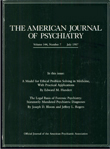This fascinating, well-researched, and amply documented monograph reveals multiple fallacies in current thinking about the epidemiology and etiology of anorexia nervosa. The author first clarifies the difference between the emergence of a disorder and the discovery of that disorder. She describes the preconditions for the emergence of the current concept of anorexia nervosa (considered to be starvation due to psychological reasons). The main precondition included development of the concept of the self, which had historical roots in the late 1700s and early 1800s. The conditions required for the discovery of the disorder are then described, and cogent reasons are provided for thinking that a disorder may exist long before the process of discovery is complete. In the case of anorexia nervosa, the author contends that the process of discovery probably began in 1860 with Louis-Victor Marcé, who described a specific kind of stomach disorder that occurred predominantly in adolescent girls. This condition was elucidated by Laségue and Gull a decade later and finally clarified as separate from Simmond's disease in the 1940s. The author makes the point that anorexia nervosa did not arise de novo in the 1870s, nor was the condition necessarily very rare by the time it was detected by the medical profession.
In the next chapters, the idea that anorexia nervosa has increased in incidence over the last few decades is questioned, and the author contends that there is virtually no evidence that an increase has occurred. Four citation patterns are noted that have contributed to the fallacious assumption that anorexia nervosa has increased in incidence: use of data and publications not relevant to the issue, unwarranted generalizations, omission of qualifications to conclusions made by the authors of the original studies, and discarding possible alternate explanations for the epidemiologic findings.
The author suggests that the certainty that there was an increase in anorexia nervosa occurred before the production of the epidemiologic data. She posits that psychiatrists in the 1960s to the 1990s were worried about the potential impact of changes in the educational status of women and expected an increase in anorexia nervosa. It is correct that dramatically improved access to advanced education for women occurred at the same time as the profession started to believe that there was an increase in anorexia nervosa, but it is an unsubstantiated cognitive leap to conclude that psychiatrists thus expected to see an increase in anorexia nervosa.
The most interesting aspect of the book is the hypothesis that there is no evidence for an increase in anorexia nervosa. Not only is this consonant with my own clinical experience, but the majority of the recent research suggests that patients with anorexia nervosa form a cohesive group who, unfortunately, are likely to develop chronic illnesses that are difficult to treat.

